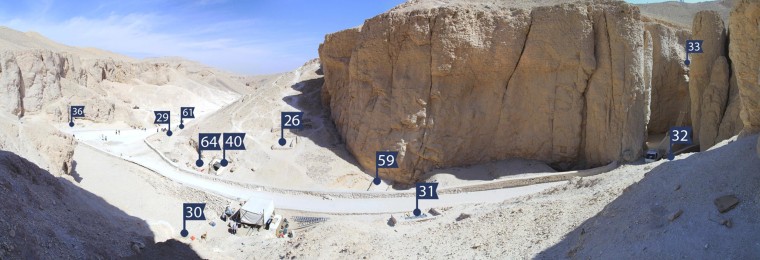Oh, mummy!
The embalmed remains of about fifty ancient Egyptians -- among them princesses, princes, and well-preserved infants from the time of the Pharaohs -- were discovered in a massive tomb in Luxor's Valley of the Kings, Egypt's Minister of Antiquities Dr. Mohamed Ibrahim said on Monday. Along with the mummies were wooden sarcophagi, funeral masks, and an abundance of mummification tools to prepare bodies for the afterlife.
The owners of the tomb were relatives of 18th dynasty Kings Thutmose lV and Amenhotep lll, who ruled in the 14th century BC.
"We had to work meter by meter recording everything by photo, drawing and measurement.”
The tomb was discovered by a team from the University of Basel in cooperation with the Ministry of Antiquities.
For the first time, archaeologists were able to identify those who were mummified by hieratic inscriptions, the cursive hieroglyphic writing on containers left in the tomb.
The names revealed the identity of more than thirty of the mummies, including princesses whose names are now appearing for the first time ever.

Further research will reveal specific details of the Pharaohnic royal structure in the 18th dynasty, as well as information about daily life and burial procedures, according to Ali El-Asfour, Head of Egyptian Antiquities.
Dr. Susanne Bickel, professor of Egyptology at Basel University and director of the University of Basel’s Kings’ Valley Project, has been excavating the site with a team of more than a dozen researchers since 2011.
They located the tomb, designated KV 40, based on old maps that had identified its presence, and pinned it down from a slight visible depression in the sand.
“We made the site accessible scientifically," Bickel said. "One knew that there was a tomb but there was nothing else known.”
The mummies' final resting place took years to excavate.
“The shaft was covered with sand which had to be dug out," she said.
When archaeologists entered the four-chamber tomb, they found floors cluttered with the piled remains of mummies, death masks made of a fragile material called cartonnage, wooden sarcophagi and jars filled with mummification material.
“There were princesses, many more women than men, probably a lot of daughters from Amenhotep III.”
Looters in antiquity and as early as the 19th century had entered the tomb first and ripped apart its contents in search of treasure.
“We could walk in, but were blocked by all this material," Bickel said. "We had to work meter by meter recording everything by photo, drawing and measurement.”
Dr. Bickel’s eureka moment came while she was examining inscriptions on jars full of mummification material and discovered the word "princess," indicating some of those entombed were the daughters of royals.
“There were princesses, many more women than men," she said, "probably a lot of daughters from Amenhotep III.”
She was also surprised by a rare discovery: well-preserved mummified infants, which also suggest a link to the royal court.
Foreign women, identified by their unusual names, may have come with diplomatic missions or may have been related to the king himself.
Bickel hopes further research will open a window on the life and death of those surrounding the king.
“Now we start the process of research of objects, inscriptions and mummies which offer us such a wonderful insight into the royal entourage in a very large sense," Bickel said. "So far, one knows very little about the non-royal tombs. Most were entirely plundered.”